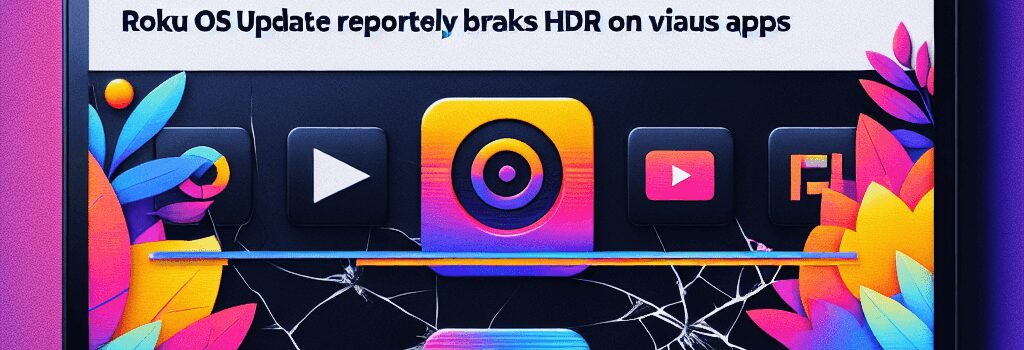Roku OS 14.5 Update reportedly breaks HDR on various apps

After the automatic rollout of Roku OS 14.5 at the end of April, users across multiple Roku TV models have reported severely washed-out colors when streaming HDR content. The issue, first flagged on Roku’s own community forum, affects major streaming apps including Disney+, Netflix, Apple TV+, Amazon Prime Video, Max and others, making HDR titles appear desaturated or “unwatchable.” Roku says it is investigating and has asked for affected users to submit logs and sample clips.
Initial Reports and Affected Apps
- Complaints began around April 28, 2025, shortly after Roku OS 14.5 installed automatically on compatible Roku TVs and streaming sticks.
- Users on TCL, Hisense, and Sharp Roku TV models report that HDR10 and Dolby Vision content lose contrast and color saturation, with midtones lifted and highlights clipped.
- Streaming sticks appear unaffected; plugging a Roku USB streaming stick into an impacted TV reportedly bypasses the issue, suggesting the bug is isolated to the TV’s system-on-chip (SoC) firmware.
- Roku’s forum moderators have confirmed the problem on Disney+ HDR and acknowledged reports on Netflix, Apple TV+, Amazon Prime Video, Max and FandangoNow.
Technical Analysis of the HDR Fault
Preliminary diagnostics indicate that Roku OS 14.5 misinterprets HDR metadata—either failing to honor SMPTE ST 2084 (PQ) electro-optical transfer function (EOTF) or incorrectly applying a gamma curve intended for SDR. The result is a near-linear transfer curve that crushes shadows and washes out highlights. Key points include:
- Metadata Pass-Through Error: HDR10 static metadata (MaxFALL, MaxCLL) and Dolby Vision dynamic metadata appear not fully passed to the TV panel’s scaler, breaking the display’s tone-mapping in most Roku TV models using MediaTek or Broadcom SoCs.
- 10-bit Processing Bypass: Users report the color bit depth being forced down to 8 bits per channel, eliminating the subtle gradient transitions that HDR relies on.
- Color Space Misalignment: The update may be switching the TV panel to a narrower BT.709 gamut for HDR content instead of the intended BT.2020 profile, resulting in out-of-gamut clipping and muted primaries.
Device Impact and Customer Workarounds
Roku has not published a device-specific list, but community reports include multiple TCL models (e.g., 55R635, 65R635), Hisense U6H, Sharp 4T-C55DL2X, among others. Affected users have tried the following without success:
- Full power-cycle and soft reset of the TV.
- Factory reset to clear user settings and cached data.
- Verifying HDMI input settings and ensuring HDMI UHD Color / Enhanced Mode is on.
- Rolling back app versions, which had no effect since the fault resides in the OS layer.
One confirmed workaround is to use an external streaming device (Roku stick, Apple TV 4K, NVIDIA Shield) which handles HDR metadata correctly and renders proper PQ curves.
Expert Opinions and Industry Context
Display-engineer Brian Butterworth, CTO of a professional calibration firm, commented: “This is a classical metadata-handling bug. Tone-mappers must apply the PQ curve and BT.2020 primaries exactly as intended. If firmware switches to BT.709, you lose up to 30% of the color gamut and raise black levels. Roku will need a patch that restores correct EOTF processing in the SoC’s video pipeline.”
By contrast, manufacturers like LG and Samsung push critical updates as optional downloads, allowing end users to delay major firmware changes until confirmed stable. Roku’s fully auto-update strategy has escalated the impact.
Roku’s Response and Next Steps
Roku’s product team has acknowledged the bug in a May 1 forum post and requested user logs via Settings > System > About > Log Collection. Internally, Roku is beta-testing a hotfix (OS 14.5.1) that reportedly restores proper HDR metadata handling. Public rollout of 14.5.1 is expected by late May. Meanwhile, Roku advises:
- Reporting every affected model number to Roku Support.
- Switching to an external HDR-capable streaming device if immediate resolution is required.
- Checking for notifications about the 14.5.1 incremental update, which will install automatically once available.
Long-Term Implications for Firmware Quality
This incident raises questions about the regression-testing protocol within Roku’s CI/CD pipeline. Firmware updates for consumer electronics must include end-to-end HDR playback tests across multiple SoCs and panel types. Our analysis suggests Roku’s test suite may lack comprehensive coverage of HDR10 and Dolby Vision workflows. Industry observers will watch closely to see if Roku adopts a phased optional update model or enhances its real-world QA benchmarks.
Conclusion
The Roku OS 14.5 update illustrates the complexity of delivering consistent HDR performance across a fragmented hardware ecosystem. While Roku races to deploy a corrective 14.5.1 patch, affected users can mitigate the issue with external devices or by temporarily disabling HDR mode where possible. Consumers and HDMI-AV integrators alike should monitor Roku’s official channels for the imminent fix and consider firmware-management best practices to avoid future disruptions.